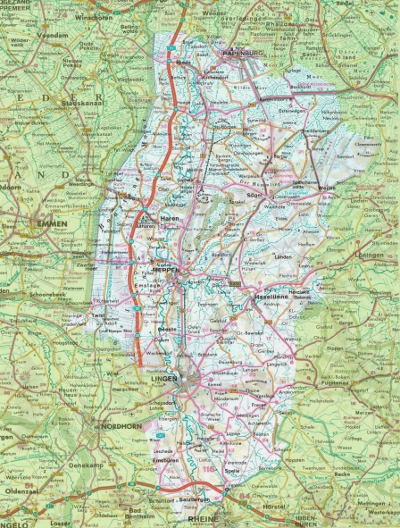The Emsland |
Among others, worth mentioning are the Ems and Hase-Auen with sandy dry grassland complexes, floodplains and alder-swamp forests, beech, pine and mixed forests, the heaths of the Hümmling, inland dunes, natural ponds, reed beds and not least rewetted highmoors.
In the Emsland district, there are over 70 different wildlife sanctuaries like the Versener Paradies, the Haselünner Kuhweide, the heathland of long barrows at Berßen, the Meppener Kuhweide with juniper grove, the Biener Busch in Lingen, the Tinner and Staverner Dose, the Bourtanger Moor to the west of the Emsland, the Ems floodplains and the Wild Moor in Papenburg. The largest wildlife sanctuary is the Esterweger Dose, a large area of contiguous bog area in the north of the county.
All plants described in Flora Emslandia were found in the territory of the district of Emsland in northwestern Germany with the larger towns Meppen, Lingen, Haselünne, Haren and Papenburg.
The river Ems
The approximately 370 km long river, which lent the Emsland its name, has its source in the North Rhine-Westphalian town Schloss Holte-Stukenbrock in Gütersloh. From its source to Lingen, it is referred to as Upper Ems. The Middle Ems extends from Lingen to Papenburg. Only that section crosses the district. From here to its mouth in the Gulf of Dollart it is called Lower Ems.
Mentioned in writing for the first time was the Ems by the Greek historian Strabo (63 B.C. To 23 B.C.) under the name of Amisia. It would flow from south to north in the ocean, parallel to the rivers Weser and Lippe. At Adam von Bremen (ca. 1050-1085 AD), a Bremen theologian and historian, the Ems appears under the names of Emisa and Emesa.

